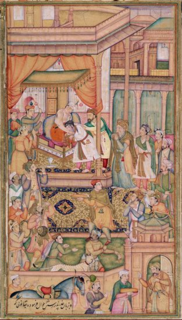| Gulrukh Begum | |
|---|---|
| Shahzadi of the Mughal Empire | |
| Died | June 1539 |
| Spouse | Nuruddin Muhammad Mirza |
| Issue | Salima Sultan Begum |
| House | Timurid |
| Father | Babur |
| Mother | Identity is disputed. May have been either Dildar Begum or Saliha Sultan Begum |
| Religion | Islam |
Gulrukh Begum (died June 1539), also known as Gulbarg Begum, was a Mughal princess, the daughter of Emperor Babur, the founder of the Mughal Empire. [1] She was also the younger half-sister of the second Mughal emperor Humayun [2] and an aunt of third Mughal emperor Akbar.

The MughalEmpire was an early-modern empire in South Asia. For some two centuries, the empire stretched from the outer fringes of the Indus basin in the west, northern Afghanistan in the northwest, and Kashmir in the north, to the highlands of present-day Assam and Bangladesh in the east, and the uplands of the Deccan plateau in South India. At its greatest extent, it was one of the largest empires in the history of South Asia.

Babur, born Zahīr ud-Dīn Muhammad, was the founder and first Emperor of the Mughal dynasty in South Asia. He was a direct descendant of Emperor Timur (Tamerlane) from what is now Uzbekistan.

Nasir-ud-Din Muḥammad, better known by his regnal name, Humayun, was the second emperor of the Mughal Empire, who ruled over territory in what is now Afghanistan, Pakistan, Northern India, and Bangladesh from 1530–1540 and again from 1555–1556. Like his father, Babur, he lost his kingdom early but regained it with the aid of the Safavid dynasty of Persia, with additional territory. At the time of his death in 1556, the Mughal Empire spanned almost one million square kilometres.
Contents
Gulrukh Begum was known for her great beauty and accomplishments in the imperial household [3] , and was the mother of Salima Sultan Begum, a wife of Akbar.

Salima Sultan Begum was the fourth wife of the Mughal Emperor Akbar, and the granddaughter of Babur.

Abu'l-Fath Jalal-ud-din Muhammad Akbar, popularly known as Akbar the Great,, and also as Akbar I, was the third Mughal emperor, who reigned from 1556 to 1605. Akbar succeeded his father, Humayun, under a regent, Bairam Khan, who helped the young emperor expand and consolidate Mughal domains in India. A strong personality and a successful general, Akbar gradually enlarged the Mughal Empire to include most of the Indian subcontinent. His power and influence, however, extended over the entire subcontinent because of Mughal military, political, cultural, and economic dominance. To unify the vast Mughal state, Akbar established a centralised system of administration throughout his empire and adopted a policy of conciliating conquered rulers through marriage and diplomacy. To preserve peace and order in a religiously and culturally diverse empire, he adopted policies that won him the support of his non-Muslim subjects. Eschewing tribal bonds and Islamic state identity, Akbar strove to unite far-flung lands of his realm through loyalty, expressed through an Indo-Persian culture, to himself as an emperor who had near-divine status.








